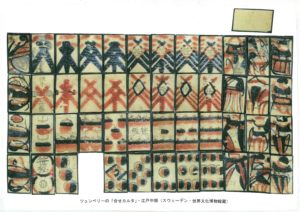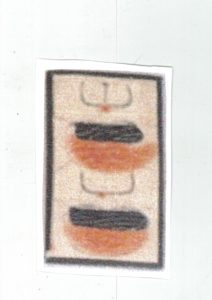(2) Discovery of Thvnberg’s Awase Carta by Markus Richert
In 2021, significant progress was made in research related to Thvnberg. When I mentioned him on the website of the Japan Playing Card Museum, I wrote that this medical doctor and botany researcher was the first person to have observed and introduced the Japanese gambling game carta to the western world. This theory remains firm today. However, Thvnberg touched on the seaman’s card game that he had happened to see on his travels, and while the description was detailed and accurate, it did not indicate that he had taken back the carta cards themselves. Therefore, it had been assumed that the first person to have taken the Japanese gambling game carta back to Europe and introduced it to people was Jan Cock Blomhoff, who was a Dutchman and the manager of the Dutch merchant house in Dejima, Nagasaki about half a century after Thvnberg.
However, in 2021 the surprising fact was discovered that Thvnberg, who predated Blomhoff by about 50 years, had brought back a Japanese carta card deck, and that this card deck had been preserved in the World Culture Museum in Sweden⁵. As Thvnberg was a gifted researcher, he had brought back an unused complete card deck as a sample.
Research on the history of Japanese gambling carta to date has not found any game cards from the 18th century, even though a large amount of 18th century literature remains. Researchers on the history of gambling carta games in 20th century Japan could use only early 19th century cards as the earliest evidence of wood printing carta. But then suddenly, an almost complete deck of carta cards from the 18th century appeared. This was an incredibly fortunate moment in the historical study of gambling carta, and we are grateful to the discoverer, Markus Richert.
Marcus Richert is an internationally famous researcher of the history of Hanahuda who understands and supports the work of the Japan Playing Card Museum. His discovery of the earliest gambling carta in existence will ensure that his name is firmly engraved in the history of gambling carta research in Japan. I congratulate and thank him from the bottom of my heart.
In addition, Richert pointed out another surprising fact. According to him, in 1995, the Swedish Embassy in Tokyo held an exhibition to commemorate the 250th anniversary of Thvnberg’s birth, ‘Japan in the national isolation and Carl Peter Thvnberg’, in which a carta deck was exhibited. Even the Emperor and Empress visited the embassy to see the exhibition.⁶ Richert talked with the person in charge of the event and confirmed that the carta deck was indeed true. However, the exhibition had focused on awarding Thvnberg’s achievements as a researcher of botany. Even though his stay in Japan was short, he conducted advanced research, took many plant specimens back to his home country, established the botany of Japan for the first time in the world, and is still respected by researchers in Japan today as the ‘Father of Japanese botany’. As a result, the carta deck, which was hardly related to the main exhibition, attracted little attention and few reports in Japan. I too did not know this background until Richert informed me, and am ashamed by my lack of research.
What is this carta? At the moment, only the data and images provided by the museum on its website are available, but I would like to describe my views when I looked at it.
The first point to note is the size of the cards. Many Europeans state that the carta cards used in Japanese gambling games are about half the size of the carta in their own countries. On the other hand, Thvnberg’s carta is 6.2 cm long and 3.5 cm wide, according to measurements by the museum. This
aspect ratio is similar to the cards of old Japanese carta; Blomhoff’s carta and Siebold’s carta in the 19th century had a ratio of about 1.7 times, while the ratio of Thvnberg’s carta is close to 1.8; they are a little longer and narrower than the 19th century cards. The ratio is also close to that of the Yomi Carta game cards depicted in the 18th century Uchu Tsurezure Gusa. Therefore, we can safely say that Thvnberg’s carta are 18th century cards.
The second point is the iconography of each carta card. First, we note the ‘6 of Ouru’ card. In the Awase Carta, which was popular in Western Japan from the early 18th century, this ‘6 of Ouru’ card was recognised as having special value, and its silver coating was proof of such high value. However, when this card entered the city Edo and became the Mekuri Carta card, the ‘6 of Ouru’ returned to a mere valueless normal card, and its silver coating was removed. On the other hand, in the Mekuri Carta game, the ‘6 of Hau’ changed to be a high point card and was given a silver coating. In the case of Thvnberg’s carta, the ‘6 of Ouru’ had already lost its silver coating. My first impression was that Thvnberg’s carta looked like a kind of Awase (Tensho) Carta in West Japan. The World Museum of Culture in Sweden did not identify the kind of cards in detail and carefully used the term ‘Japanese carta’, not Mekuri Carta or Awase Carta.
The third point is that the silver-coated cards in Thvnberg’s carta are the ‘1 of Hau’, ‘2 of Hau’, ‘Sota of Hau’, ‘Uma of Hau’, and ‘Kiri of Hau’. In the 19th century, the Awase Carta standardised also the silver coating of the ‘2 of Ouru’, but Thvnberg’s carta does not have this. Thvnberg’s carta cards are older than the 19th century Japanese carta. In the silver coating of Thvnberg’s cards, the figure of the coating on the ‘2 of Hau’ is a dragon wrapped around a club. There was a similar image in Uchu Tsurezure Gusa in the 18th century, and also on the remains of the Awase Carta cards made by Minatoya in Kyoto in the mid 19th century. However, the pattern is not found in any regional pattern of Mekuri Carta, suggesting that it is an Awase Carta deck.
The fourth point is, looking closely at the iconography of this carta, the following features.
1) First of all, the suit mark ‘Hau’ is expressed by a thick dark blue line by the stencil method. Unlike the old one, which was represented by a thin hand-drawn line, the cards are judged to be from a time after the stencil method came to be used.
2) Looking at the ‘3 of Ouru’ card, the three suit marks ‘Ouru’ (gold coin) flow from the upper left to the bottom right of the card. This carta design is exceptional because there are many Awase Carta and Mekuri Carta from 19th century Edo with a pattern flowing from the upper right to the lower left. In addition, even looking at the so-called regional pattern that survived to modern Japan, there are many with a pattern flowing down the left, and the same direction as Thvnberg’s carta is scattered in ‘Kin-gyoku’, ‘Ko-matsu’ which resembles the pattern of the carta card of ‘Matsuba-ya’ in Kyoto, and ‘Ko-matsu’ which resembles ‘Tsuru-ya’ in Kyoto.
3) In Thvnberg’s carta, there is a jagged pattern on the outer edge of the suit mark ‘Ouru’. The same is found on the modern ‘Kin-gyoku’ and ‘Ko-matsu’.
4) In addition, there is a line similar to a Kanji character at the top of the suit mark of the ‘2 of Koppu’ card, which is the remains of the leg part of the ‘Chalice Cup’. The suit mark of ‘Koppu’ originally meant ‘Cup’ of ‘Chalice’, but it was reversed up and down and became ‘Pouch’, and the legs of the previous ‘Chalice’ were transformed into the top of the ‘Pouch’. However, the figure of the leg of the ‘Chalice Cup’ remains in the line of this suit mark.
5) Mekuri Carta also inherits the red diamond in the centre of the card from the ‘5 of Hau’ to ‘9 of Hau’ or the blue diamond in the centre of the card from the ‘5 of Isu’ to ‘9 of Isu’. In short, the design of Thvnberg’s carta was handed over to Mekuri Carta, then remained in some modern regional pattern cards.
6) The picture design of Thvnberg’s carta is very similar to that of the Mekuri Carta. It is likely that craftsmen of Kyoto smoothly drew pictures using the same familiar work procedures at all times.However, the hand-drawn lines are still thin, clean as a whole, and ‘stylish’ to suit the upper-class society. There is little impression of the favourite ‘insensitively’ thick painting of the popular Mekuri Carta of the Edo city.
7) The picture of the ‘1 of Hau’ (‘Azapin’) is as thin as the ‘1’ of the other three suit marks, and the original image of a ‘dragon’ is still clear on its face. There is no sign of the heavy navy blue colouring of the ‘1 of Hau’ of Mekuri Carta of later generations.
8) On the other hand, on the ‘2 of Isu’ card of Thvnberg’s carta, there are some Japanese Kanji characters, namely ‘Ne-Moto’ (base) in the upper centre of the card, ‘Sasa-Gyoku’ (bamboo leaf-best) in the lower centre, and ‘Mu-Rui’ (unrivalled) in the centre of the card. We can compare this with a modern regional pattern carta ‘Kin-gyoku’ which has the Kanji characters ‘Ne-Moto’ (base) in the upper centre of the ‘2 of Isu’ card, ‘Kin-gyoku’ (gold-best) in the lower centre, and ‘Fuji-Wara’ (a family name) in the centre. ‘Ne-Moto’ is common and ‘Sasa-Gyoku’ and ‘Kin-gyoku’ are similar but ‘Mu-Rui’ in Thvnberg’s carta is considerably different from ‘Fuji-Wara’ of ‘Kin-gyoku’.
9) Moreover, on the ‘3 of Ouru’ card there are the Hiragana letters ‘Mu-ru-i’ in the upper right and ‘Sa-sa-shi-ma-ya’ in the lower left. ‘Mu-ru-i’ (Hiragana characters) is of course the same as ‘Mu-rui’ (Kanji characters), and ‘Sa-sa-shi-ma-ya’ (Hiragana characters) is the same as ‘Sasa-Shima-Ya’ (Kanji characters). This is the name of an unknown carta shop. Therefore, ‘Sasa-Gyoku’ of the ‘2 of Isu’ is assumed to be the ‘best’ card of the card-maker ‘Sasashimaya’.
10) n addition, this ‘Sasa-Gyoku’ appeared as ‘Sasa’ (Kanji characters) in the red diamond in the centre of cards from the ‘5 of Hau’ to ‘9 of Hau’ and as ‘Gyoku’ (Kanji characters) in the blue diamond in the centre of cards from the ‘5 of Isu’ to ‘9 of Isu’. Originally, in the case of Mekuri Carta, there were no Kanji characters in this part, but later the name of the maker appeared, and sometimes the Kanji characters for the numbers 6, 7, 8, and 9 were included in this part.
11) In addition, ‘Sasa-Gyoku’ (Kanji characters) appeared in the centre of the ‘6 of Koppu’. Usually, in European carta and Japanese Tensho carta, the name of the maker appeared both on the ‘4 of Ouru’ and ‘6 of Koppu’ but unfortunately, the ‘4 of Ouru’ card is missing in Thvnberg’s carta and we cannot discuss this point further.
In this way, a detailed examination reveals the identity of this carta. It is judged that this carta is an Awase Carta, which were gambling game carta made in Kyoto and Osaka and were popular in western Japan. The question arises, where did Thvnberg obtain this deck? There is no hard evidence, but I think Thvnberg acquired it in Nagasaki, where he stayed for a long time, rather than Osaka, where he stayed for only a few days on his journey to Edo.
⁵ http://collections.smvk.se/carlotta-em/web/object/1000639
⁶ Under ‘Schedule of Their Majesties the Emperor and the Empress’ on the website of the Imperial Household Agency is the entry ‘Sunday, March 26, 1995: Viewing by Their Majesties the Emperor and the Empress (Thvnberg Exhibition) (Embassy of Sweden)’.












